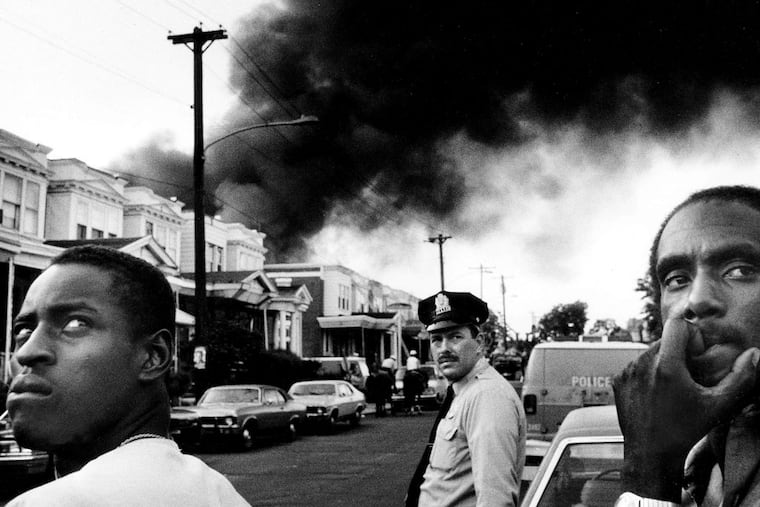30 years later, MOVE's lessons still not learned
May 13 marks the 30th anniversary of a dark day in Philadelphia's history - an event that captured much national attention at the time but seems largely forgotten now, except by those who personally lived it.

May 13 marks the 30th anniversary of a dark day in Philadelphia's history - an event that captured much national attention at the time but seems largely forgotten now, except by those who personally lived it.
On that day, a series of reckless actions (and cowardly inactions) by government and police culminated in a decision to bomb the Osage neighborhood in West Philadelphia, causing the deaths of 11 people (five of them children) and a conflagration that destroyed 60 homes. In an attempt to rid a black neighborhood of a disruptive group, also largely black, the city's law enforcement mechanisms brought devastation on the entire community.
Nothing quite like it had ever happened before, and nothing like it has ever happened since. Perhaps the peculiar circumstances of the MOVE confrontation, utterly astonishing in their own context, are what made it so easy for most people to dismiss it as a historical anomaly, unlikely ever to recur. Three decades later, that's an idea we need to challenge.
At a moment when institutionalized violence against black communities is once again in the spotlight, the anniversary of the MOVE confrontation invites comparisons that suggest how little progress has been made. In its final report, the 11-member commission appointed to investigate the confrontation made the case that institutional racism had subtly informed critical decisions at every point along the way.
Noting that this kind of response to crisis would never have occurred had the Osage neighbors been white, the report underscored that the city displayed racism in its dealings with both perpetrators and victims. Officials and police were indisputably reckless with the lives of black MOVE members and their children, and equally reckless with the lives and homes of the black neighbors they aimed to help.
In that way, the MOVE narrative would appear to resemble the story of policing in black neighborhoods today, where innocent citizens are too often put at risk by the zeal to maintain order, even if it means failing to distinguish between criminals and innocent members of the community.
But if racism were the only lesson of the MOVE confrontation, we wouldn't need to look back so far for an education.
What gives that historical record particular meaning is the way in which, 30 years ago, the MOVE confrontation anticipated new challenges of urban policing in minority neighborhoods today. Those challenges make even more alarming certain persistent disparities between the high standards to which we hold police and the grim realities caught recently on video in city after city.
The MOVE incident was a case in which an urban police force was better equipped with military-grade weaponry and explosives than with the skills to manage a difficult and sensitive situation. In that sense, it was a harbinger of the militarization of urban police forces, and the urgent need for 21st-century police personnel to be trained in the exercise of restraint rather than just brute force.
According to the MOVE Commission report, explosive charges used to penetrate the MOVE house in 1985, as well as the incendiary "bomb" dropped on the roof of the house, had all been given by FBI agents to Police Department "Bomb Disposal Unit" members, who had virtually no experience in the proper use of such material. Similarly, the weapons used to fire 10,000 rounds into the MOVE house on May 13 included M-16 semi-automatic rifles, Uzis, M-60 machine guns, and other military-grade firearms.
Thirty years later, news reports confirm that drones, armored vehicles with high-power weapons, tanks, and battlefield helicopters are being supplied by the Department of Homeland Security to local law enforcement personnel with little or no training in their use.
The recent cases of violence against black men that have garnered national attention appear to involve old-fashioned, low-tech weapons: fists, choke holds, pistols, anger, questionable judgment. But tensions are running high in our society, which is under threat from outside terrorism and our own social divisions. The mood in our cities is hair-trigger tense. It is just a matter of time before more sophisticated weaponry is once again used against civilians under circumstances that multiply the casualty levels to "MOVE-like" proportions.
The Justice Department report released in March, "Assessment of Use of Deadly Force in the Philadelphia Police Department," found shortcomings in the training and supervision of police officers similar to those outlined in the MOVE Commission report. The 2015 report also noted deficiencies in civilian oversight of police operations and lack of transparency in internal investigations, all giving rise to distrust of law enforcement by the community.
Sadly, there is plenty of evidence of contemporary racism in cities, and the challenge of policing in poor minority neighborhoods is as great as ever - perhaps more so, now that social media can quickly rally and ignite crowds, producing dangerous confrontations.
The special insight that MOVE brings us from three decades ago is the critical importance of effective police training - not just lip service and written manuals but meaningful training that is continually reinforced - and the inevitable risk of supplying military-grade weapons to even the best-trained urban police force.
H. Graham McDonald was deputy director and counsel of the Philadelphia Special Investigation Commission on the 1985 MOVE confrontation